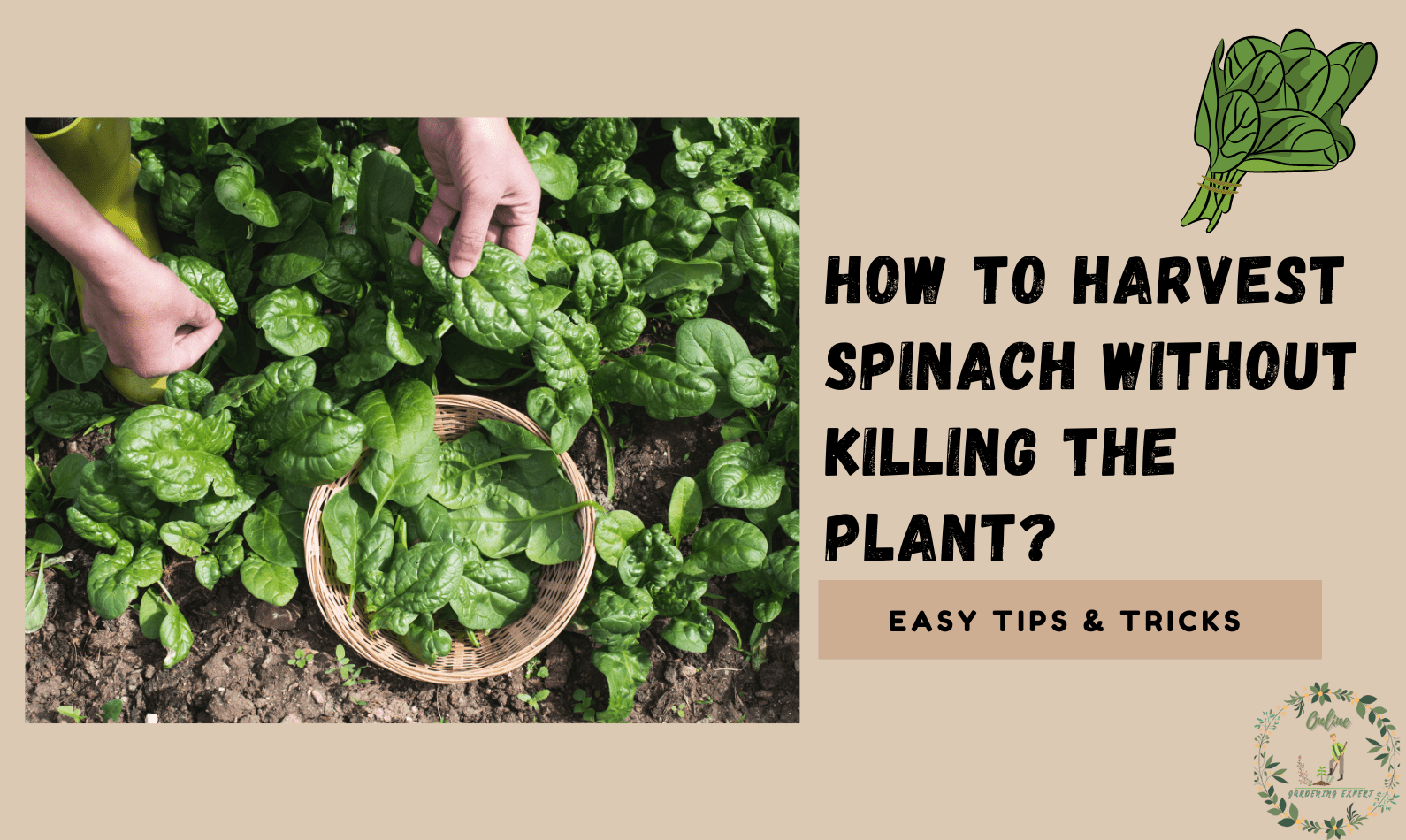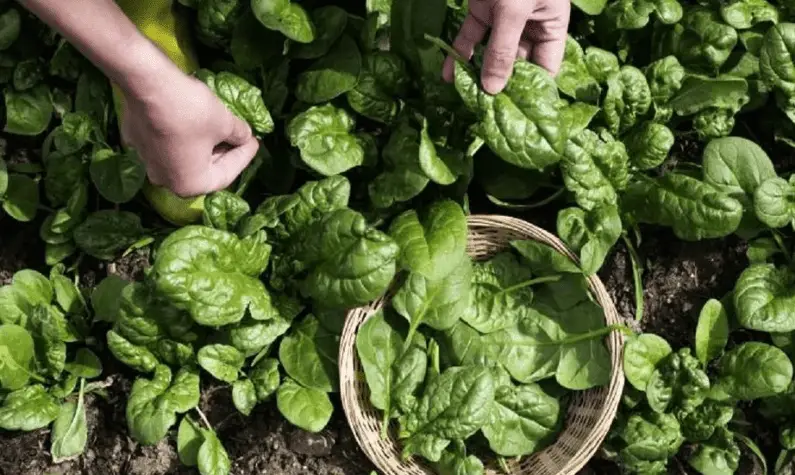How To Harvest Spinach Without Killing The Plant? While there’s nothing quite like a freshly grown salad straight from your garden, are you aware of the proper way to harvest spinach without harming the plant? The delicate leaves are densely filled with nutrients, vitamins, and antioxidants. Simply combine them in a bowl with some goat cheese and cherry tomatoes, and you’ve got yourself a salad to die for.
However, as you step outside the door to pluck a few leaves, you must be gentle not to harm the plant on your first harvest. Here’s how to select the best leaves and ensure that the plant continues to thrive throughout the season.
Contents
- Best Time To Plant Spinach
- When To Harvest Spinach?
- How To Harvest Spinach Without Killing The Plant?
- Common Mistakes That May Happen While Harvesting Spinach
- Nutritional Benefits Of Spinach
- Conclusion: How To Harvest Spinach Without Killing The Plant
- If possible, In Which Way I Can Harvest Spinach Without Killing The Plant?
- How to Store Fresh Spinach?
- How Should I Dry Fresh Spinach?
- How Can I Freeze Fresh Spinach?
Best Time To Plant Spinach
One of the most significant advantages of spinach is its adaptability to different planting seasons. It is possible to grow it in the spring, fall, and even winter. If you reside in a milder climate, you may not even need to cover it during the winter months if you have a fireplace. Sprouting and growth of spinach plants require temperatures no greater than 70oF for a period of around six weeks. As soon as the earth defrosts or has softened enough to work in, you can begin planting your seeds or plants.
Growing spinach in the fall will allow you to harvest it before the first frosts hit. If you want to harvest your spinach in the early spring, you should grow it before the first frosts hit. Cover it with a layer of mulch to protect the delicate plants from frost, and then uncover it as soon as the temperature rises above 5 degrees Fahrenheit.
Summer is not the best time to plant spinach, at least not the common kind. Seeds require cool conditions to germinate; therefore, you must wait for the soil to cool before planting.
When To Harvest Spinach?
The time it takes to harvest spinach varies depending on when you planted it. Plant your spinach no later than the end of April to enjoy a salad of leafy greens in the early summer months. Because spinach takes around six weeks to reach maturity, you will be able to harvest some leaves at the beginning of June.
When spinach is sown no later than September, it will be ready for harvest in the early spring. This will provide enough time for the plant to mature and enter dormancy to endure the winter months. Even a modest spinach harvest can be accommodated, but be careful not to harm the plant. In addition, you’ll need to supply frost protection.
Plant the spinach seeds approximately eight weeks before the first frost date to ensure a successful harvest. Depending on your region, the first frost may come as early as the beginning of September or as late as the end of November. Zones that do not experience frost have the advantage of being able to plant spinach nearly whenever they choose.
How To Harvest Spinach Without Killing The Plant?
So, what exactly is it about harvesting spinach that is so difficult? When you pick the spinach leaves correctly, you can get three to four harvests out of each plant. Because of a poor spinach crop, the plant dies on the first day of harvesting. Because the annual plant is delicate, you must handle it with care.
Begin by keeping an eye on your plant until the leaves have reached the optimum size. Yes, baby spinach is delightful, but allow it to mature until it is somewhere in the middle of the plant. Avoid letting it mature too much; older leaves become harder and bitter, so you want it to be in the middle of its growth cycle. Get out your gardening scissors and begin by trimming the outside leaves first, avoiding the center of the plant. A clean-cut should be made at the base of the spinach plant stem.
The outer leaves are older and more developed than the inner leaves. Leaving the center of the plant permits those leaves to continue to grow and be ready for the following harvest.
To be frank, it is not at all impossible to harvest the entire plant. Plants should be carefully pruned at the base but not too low not to damage the growing point. When the plant is correctly pruned, it can regenerate and produce up to two further harvests.
Common Mistakes That May Happen While Harvesting Spinach
The most typical mistake that amateur gardeners make is choosing the leaves in the plant’s core or picking too many leaves at a given time. Never select more than one-third of the spinach plant at a time, and always begin with the outer leaves. After harvesting, do not fertilize the plant to encourage it to produce again. All spinach requires is water to regrow, and it will do so.
Cutting or picking the entire spinach plant too low and harming the growing point will result in the plant’s eventual death. The growth point of a plant is the crown, which is the point at which the stems connect to the plant’s root system. At least 2 inches should be removed from the crown.
Nutritional Benefits Of Spinach
If Popeye didn’t make it plain enough why spinach should be included in your diet, we’re here to clarify it for you. Even a single 100-gram serving of leafy greens contains around 34% of the recommended vitamin C intake daily.
Because spinach contains a high concentration of iron, calcium, and magnesium, it is extremely beneficial for maintaining healthy skin, hair, and bones. It can also aid in the control of diabetes and high blood pressure.
Conclusion: How To Harvest Spinach Without Killing The Plant
This leafy green is an annual crop that thrives in cooler climates. It yields approximately three harvests per plant per season when grown properly and harvested correctly. Always start with the outer leaves and work your way up to the crown. You can even chop the entire plant down to the ground, and it will regrow. In this way, spinach can be harvested without killing the plant.
Frequently Asked Questions (FAQ)
If possible, In Which Way I Can Harvest Spinach Without Killing The Plant?
It’s normal for a spinach plant to be harvested more than once, although beginners may have to kill a few plants before they locate the right location. Make sure to follow our instructions and keep an eye on the plants for a few days after being harvested. You’ll know you’ve done a good job when the plant begins to show signs of regeneration.
Learn more about How To Harvest Oregano Without Killing The Plant?
How to Store Fresh Spinach?
In the event that you have picked an excessive amount of spinach or decided to pluck all of the spinach from your garden and need to store it for later use, here is what you should do to ensure that it remains fresh for a longer period.
Wrap the freshly cut and washed leaves loosely in moist kitchen towels and store them in a tightly sealed plastic or glass container for up to two weeks. Within a week of harvesting, or until the leaves begin to wilt and lose their color, begin to use the leaves.
How Should I Dry Fresh Spinach?
You can dehydrate spinach leaves to keep them fresh for up to a week, which is useful if you want to keep them fresh for more than a few days. It is possible to dry fresh spinach in a variety of ways. Here are some suggestions.
One option is to utilize a food dehydrator, which aids in the removal of moisture from the plant material.
If you don’t have a food dehydrator, you can dry the leaves in the oven or hang them out to dry. To use the oven, just arrange the cleaned leaves (which can also be roughly chopped) on a baking sheet, place the baking sheet in the oven on its lowest temperature setting, and leave the baking sheet in the oven for 2-3 hours, or until the leaves are dry and crispy.
Another option is to dry your clothes by hanging them. This procedure is fairly straightforward. Nothing more than a handful of spinach leaves tied together with a piece of twine and placed upside down in a well-ventilated room will suffice. Once they’ve dried and crumbled, store them in an airtight bag or container to prevent them from drying out again.
How Can I Freeze Fresh Spinach?
Frozen vegetables are a tremendous time-saver and extremely valuable to have on hand, especially when certain vegetables are out of season or difficult to come by.
- If your garden produces more spinach than you can use in one sitting, simply store the excess spinach leaves in the freezer for later use.
- If you’re expecting to use the spinach within a few weeks, you can simply wash the leaves and place them in a freezer bag before putting them in the freezer.
- If you’re searching for long-term storage, blanching and freezing the leaves is a superior and more efficient method of preserving the leaves for future use.
Learn more about how long spinach dip last in the fridge?
The way it works is as follows. Prepare by blanching the leaves in boiling water for up to 30 seconds, then submerging them in cold water for up to a minute to halt the cooking process, pressing them down with a spoon to drain the water, and then storing them in freezer bags in a freezer.
As you can see, harvesting and preserving spinach is a really straightforward process! Whatever harvest method you choose, keep in mind that you should only harvest about a third of the plant at a time to allow the plant to regrow new leaves and let you have numerous harvests in a season.



